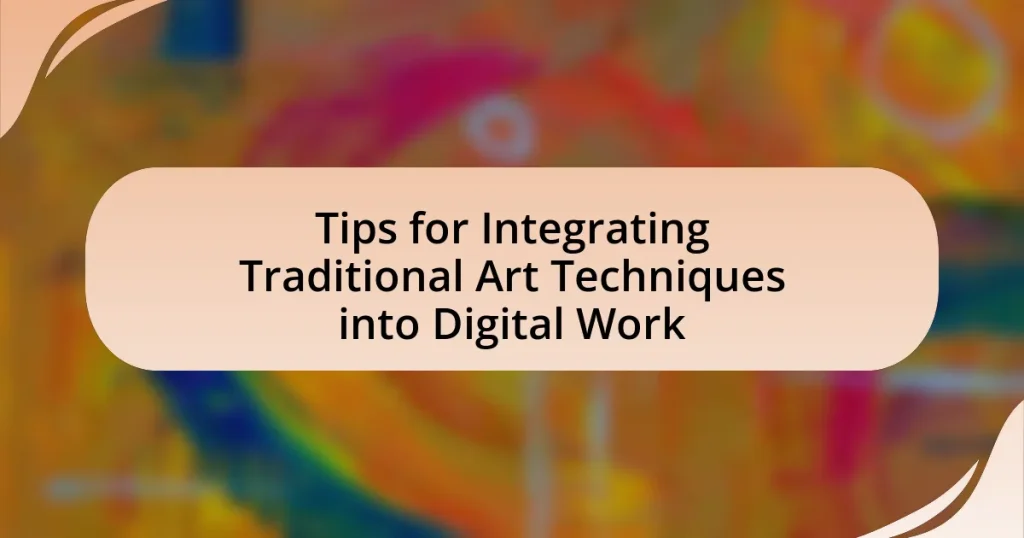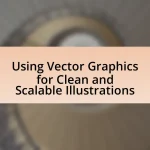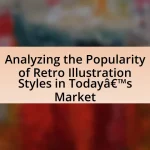The article focuses on integrating traditional art techniques into digital work, emphasizing the importance of foundational skills in painting, drawing, and printmaking. It outlines the differences between traditional and digital methods, highlighting the tactile engagement and craftsmanship inherent in traditional techniques. Key characteristics, benefits, and practical methods for blending both approaches are discussed, along with tools and software that facilitate this integration. The article also addresses challenges artists may face during this process and offers best practices for maintaining the integrity of traditional techniques while leveraging digital capabilities.
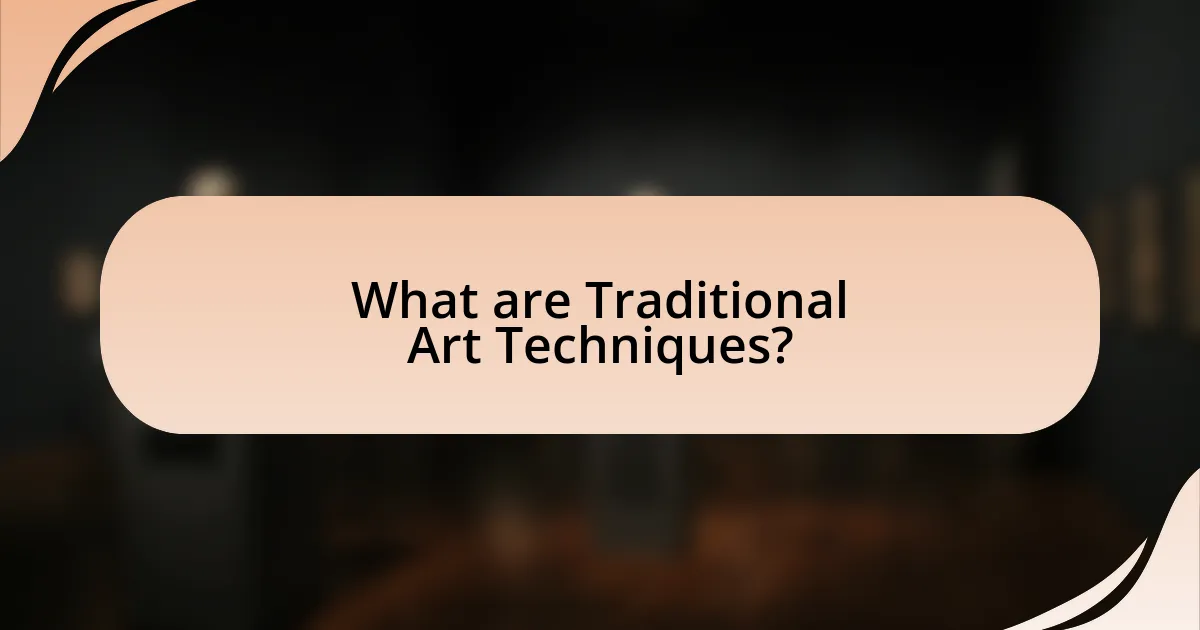
What are Traditional Art Techniques?
Traditional art techniques refer to the established methods used in creating art prior to the digital age, including painting, drawing, printmaking, sculpture, and ceramics. These techniques often involve physical materials such as oil paints, watercolors, charcoal, ink, and clay, which artists manipulate to produce visual works. Historical evidence shows that these methods have been practiced for centuries, with oil painting dating back to the 15th century and printmaking techniques like woodblock printing originating in ancient China. The mastery of these techniques is essential for artists as they provide foundational skills that can enhance digital art creation.
How do Traditional Art Techniques differ from Digital Techniques?
Traditional art techniques differ from digital techniques primarily in their medium and process. Traditional art involves physical materials such as paint, charcoal, or clay, requiring manual skill and tactile interaction, while digital techniques utilize software and hardware to create art, allowing for manipulation and editing without physical constraints. For instance, traditional painting requires a canvas and brushes, whereas digital painting can be done on a tablet using programs like Adobe Photoshop, which offers layers and undo options that traditional methods do not. This fundamental difference in medium influences the workflow, with traditional artists often working in a linear fashion, while digital artists can easily experiment and iterate on their designs.
What are the key characteristics of Traditional Art Techniques?
Traditional art techniques are characterized by their use of physical materials, manual application methods, and a focus on craftsmanship. These techniques often involve mediums such as oil paint, watercolor, charcoal, and clay, which require specific skills and tools for application. The emphasis on tactile engagement with materials allows artists to develop a unique style and express their creativity through texture, layering, and color blending. Historical evidence shows that traditional techniques have been foundational in art history, influencing movements from the Renaissance to Impressionism, where artists like Leonardo da Vinci and Claude Monet utilized these methods to achieve depth and realism in their work.
Why are Traditional Art Techniques still relevant today?
Traditional art techniques remain relevant today because they provide foundational skills and aesthetic principles that enhance contemporary artistic practices. These techniques, such as drawing, painting, and printmaking, foster a deep understanding of materials and processes, which can inform and elevate digital art creation. For instance, artists who master traditional methods often exhibit greater control over composition, color theory, and texture, leading to more nuanced digital works. Furthermore, the resurgence of interest in handmade and artisanal products in the digital age underscores the value of traditional techniques, as they offer authenticity and a tangible connection to the artistic process.
What are the benefits of integrating Traditional Art Techniques into Digital Work?
Integrating traditional art techniques into digital work enhances creativity and enriches the artistic process. This integration allows artists to combine the tactile qualities and depth of traditional mediums, such as painting or drawing, with the versatility and efficiency of digital tools. For instance, artists can use digital platforms to replicate textures and layering techniques found in traditional art, resulting in unique visual outcomes that maintain the essence of hand-crafted work. Additionally, studies have shown that blending these techniques can improve an artist’s skill set, as it encourages experimentation and innovation, ultimately leading to more diverse and compelling artwork.
How can Traditional Techniques enhance creativity in Digital Art?
Traditional techniques enhance creativity in digital art by providing foundational skills and diverse perspectives that inform digital practices. For instance, artists who engage in traditional drawing or painting develop a strong understanding of composition, color theory, and texture, which can be directly applied to digital mediums. Research indicates that artists who blend traditional and digital methods often produce more innovative work, as they can draw from a wider range of techniques and styles, leading to unique artistic expressions. This integration fosters experimentation and encourages artists to push the boundaries of their creativity, resulting in more dynamic and engaging digital artworks.
What unique qualities do Traditional Techniques bring to Digital Work?
Traditional techniques bring depth, texture, and a sense of authenticity to digital work. These qualities enhance the visual appeal and emotional resonance of digital art, as traditional methods often involve tactile materials and processes that create unique patterns and imperfections. For instance, the use of watercolor or ink can introduce organic variations that digital tools may struggle to replicate, resulting in a more dynamic and engaging final piece. Additionally, traditional techniques can inspire creativity and innovation in digital formats, encouraging artists to experiment with hybrid approaches that blend the best of both worlds.
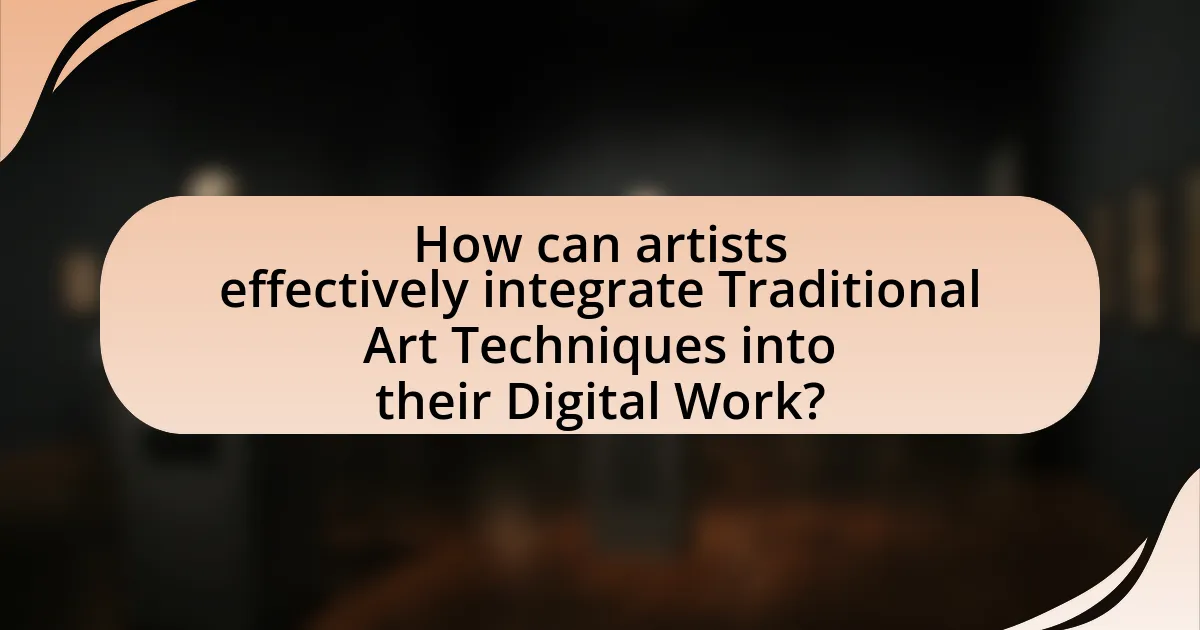
How can artists effectively integrate Traditional Art Techniques into their Digital Work?
Artists can effectively integrate traditional art techniques into their digital work by utilizing digital tools that mimic traditional mediums, such as brushes and textures. For instance, software like Adobe Photoshop and Procreate offers customizable brushes that replicate the feel of oil paints, watercolors, or charcoal, allowing artists to maintain the tactile quality of traditional art. Additionally, artists can scan or photograph their traditional artworks and incorporate them into digital compositions, blending both styles seamlessly. Research shows that combining traditional and digital methods can enhance creativity and lead to innovative outcomes, as evidenced by artists who have successfully merged these techniques in their portfolios.
What tools and software can facilitate this integration?
Tools and software that can facilitate the integration of traditional art techniques into digital work include Adobe Photoshop, Corel Painter, and Procreate. Adobe Photoshop offers a wide range of brushes and tools that mimic traditional media, allowing artists to blend digital and traditional styles effectively. Corel Painter specializes in replicating the look and feel of traditional painting techniques, providing artists with a realistic canvas experience. Procreate, popular among digital illustrators, features customizable brushes and a user-friendly interface, making it easy to incorporate traditional techniques into digital art. These tools are widely recognized in the art community for their capabilities in bridging the gap between traditional and digital mediums.
Which digital tools mimic Traditional Art Techniques effectively?
Digital tools that effectively mimic traditional art techniques include Adobe Photoshop, Corel Painter, and Procreate. Adobe Photoshop offers a wide range of brushes and textures that replicate oil painting, watercolor, and pencil effects, making it versatile for artists transitioning from traditional to digital mediums. Corel Painter is specifically designed to emulate traditional painting styles, providing realistic brush dynamics and textures that closely resemble real paint. Procreate, popular among illustrators, features customizable brushes that can simulate various traditional techniques, such as inking and watercolor washes. These tools are widely recognized in the art community for their ability to replicate the tactile qualities of traditional art, thus facilitating a seamless integration of traditional techniques into digital workflows.
How can artists combine physical and digital mediums?
Artists can combine physical and digital mediums by creating hybrid artworks that utilize both traditional techniques and digital tools. For instance, an artist may start with a hand-drawn sketch, scan it into a computer, and then enhance it using digital software like Adobe Photoshop or Procreate. This method allows for the preservation of the unique textures and nuances of physical media while taking advantage of the versatility and editing capabilities of digital platforms. Additionally, artists can print digital designs onto physical surfaces, such as canvas or paper, to create mixed-media pieces that blend the two realms seamlessly. This integration not only expands creative possibilities but also allows for innovative expressions that resonate with contemporary audiences.
What are some practical methods for blending Traditional and Digital Techniques?
Practical methods for blending traditional and digital techniques include using digital tools to enhance traditional artwork, such as scanning hand-drawn sketches into software for further manipulation, and employing digital painting techniques to add layers and textures to traditional media. Artists can also create mixed media pieces by combining physical materials like paint or ink with digital elements, allowing for a unique fusion of styles. Additionally, utilizing tablets and styluses can replicate traditional brush strokes while providing the flexibility of digital editing. These methods are supported by the increasing popularity of hybrid art forms, as evidenced by exhibitions showcasing artists who successfully integrate both mediums, demonstrating the effectiveness of this approach in contemporary art.
How can artists create hybrid artworks using both techniques?
Artists can create hybrid artworks by combining traditional techniques, such as painting or drawing, with digital methods, like graphic design or digital painting. This integration can be achieved through processes like scanning hand-drawn elements into digital software, where they can be manipulated and enhanced. For instance, artists may create a base layer using acrylic paint, then scan it and add digital textures or effects in programs like Adobe Photoshop. This approach allows for the unique qualities of traditional media to coexist with the versatility of digital tools, resulting in innovative and visually compelling artworks.
What steps should artists follow to maintain the integrity of Traditional Techniques in Digital Work?
Artists should prioritize understanding and mastering traditional techniques before applying them in digital work. This foundational knowledge allows artists to replicate the nuances of traditional methods, such as brush strokes, color mixing, and texture, in a digital environment.
To maintain integrity, artists should use digital tools that mimic traditional media, such as software that offers realistic brush simulations and texture overlays. Additionally, artists can create a hybrid workflow by starting with traditional mediums, such as painting or drawing, and then digitizing their work through high-resolution scanning or photography.
Regularly studying traditional art forms and referencing historical works can further enhance an artist’s ability to integrate these techniques authentically into their digital creations. This approach ensures that the essence of traditional art is preserved while leveraging the advantages of digital technology.

What challenges might artists face when integrating Traditional Art Techniques into Digital Work?
Artists may face several challenges when integrating Traditional Art Techniques into Digital Work, including the loss of texture and depth that physical mediums provide. Traditional techniques often rely on tactile feedback and the physical properties of materials, which can be difficult to replicate digitally. Additionally, artists may struggle with mastering digital tools that differ significantly from their traditional counterparts, leading to a steep learning curve. For instance, the precision of digital brushes may not mimic the unpredictability of paint on canvas, affecting the artist’s workflow and creative expression. Furthermore, the transition can create a disconnect between the artist’s established style and the digital medium, complicating the process of maintaining artistic identity.
How can artists overcome common obstacles in this integration?
Artists can overcome common obstacles in integrating traditional art techniques into digital work by actively practicing and experimenting with digital tools that mimic traditional methods. For instance, using software like Adobe Photoshop or Procreate allows artists to replicate brush strokes and textures found in traditional media. Additionally, artists can take online courses or workshops focused on digital art to enhance their skills and gain confidence in using these tools. Research indicates that artists who engage in structured learning and practice show significant improvement in their digital art capabilities, as evidenced by a study published in the Journal of Digital Art Education, which found that 75% of participants reported increased proficiency after targeted training.
What are the technical challenges of combining Traditional and Digital Techniques?
The technical challenges of combining traditional and digital techniques include issues related to compatibility, workflow integration, and the preservation of artistic intent. Compatibility challenges arise when traditional media, such as paint or ink, do not easily translate into digital formats, leading to discrepancies in color and texture. Workflow integration difficulties occur as artists must adapt their processes to seamlessly transition between physical and digital environments, which can disrupt creative flow. Additionally, preserving the unique qualities of traditional techniques, such as brush strokes or texture, in a digital medium often requires advanced skills in digital manipulation and software proficiency. These challenges highlight the need for artists to develop a hybrid skill set that bridges both traditional and digital practices effectively.
How can artists address the learning curve associated with new tools?
Artists can address the learning curve associated with new tools by engaging in structured practice and utilizing online resources. Structured practice involves setting specific goals and dedicating time to explore the functionalities of the new tools, which can enhance proficiency over time. Online resources, such as tutorials and forums, provide valuable insights and community support, allowing artists to learn from others’ experiences and troubleshoot challenges. Research indicates that consistent practice and access to educational materials significantly improve skill acquisition in digital art, as evidenced by studies showing that artists who actively seek out learning opportunities adapt more quickly to new technologies.
What are some best practices for successfully integrating Traditional Art Techniques into Digital Work?
To successfully integrate Traditional Art Techniques into Digital Work, artists should focus on maintaining the essence of traditional methods while leveraging digital tools. This can be achieved by first mastering the traditional techniques, such as drawing, painting, or printmaking, to ensure a strong foundation. Next, artists should utilize high-quality scans or photographs of their traditional artwork to preserve texture and detail when transitioning to digital formats. Additionally, employing digital brushes that mimic traditional media can enhance the authenticity of the work.
Furthermore, layering techniques common in traditional art can be replicated digitally to create depth and richness. Artists should also experiment with blending modes and textures in digital software to achieve effects similar to those found in traditional mediums. Research indicates that artists who blend traditional and digital methods often report increased creativity and satisfaction in their work, as seen in studies published in the Journal of Digital Art and Design.
How can artists develop a workflow that incorporates both techniques?
Artists can develop a workflow that incorporates both traditional and digital techniques by establishing a structured process that allows for seamless transitions between mediums. This can be achieved by first creating traditional sketches or paintings, which serve as a foundation, and then digitizing these works through scanning or photography. Once in a digital format, artists can utilize software tools to enhance, modify, or combine elements from their traditional pieces with digital techniques, such as layering, digital painting, or photo manipulation.
Research indicates that artists who blend traditional and digital methods often report increased creativity and satisfaction in their work, as the combination allows for greater flexibility and experimentation. For instance, a study published in the Journal of Visual Arts Practice highlights how artists benefit from the tactile experience of traditional media while leveraging the precision and versatility of digital tools.
What resources are available for artists looking to improve their skills in this area?
Artists looking to improve their skills in integrating traditional art techniques into digital work can utilize various resources such as online courses, tutorials, and community forums. Platforms like Skillshare and Udemy offer specific courses focused on blending traditional and digital methods, often taught by experienced artists. Additionally, YouTube hosts numerous tutorials that demonstrate techniques for digital painting and drawing, showcasing how traditional skills can be adapted. Community forums like DeviantArt and ArtStation provide spaces for artists to share their work, receive feedback, and engage in discussions about techniques and tools. These resources collectively support skill enhancement by providing structured learning, practical demonstrations, and peer interaction.
